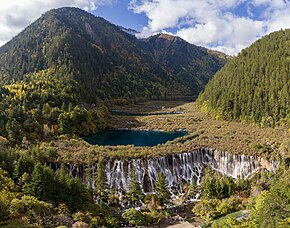
Back وادي جيوتشاي Arabic Jiuzhaigou AST Tzyuçjayqou Azerbaijani Дзюджайгоу Bulgarian চিউচাইকৌ উপত্যকা Bengali/Bangla གཟི་རྩ་སྡེ་དགུ་ Tibetan Jiuzhaigou Catalan Ťiou-čaj-kou Czech Jiuzhaigou-dalen Danish Jiuzhaigou German
| Jiuzhaigou Valley Scenic and Historic Interest Area 九寨沟风景名胜区 | |
|---|---|
From top, left to right: Five Flower Lake, Five Colour Pond, Nuorilang Falls, Pearl Shoal Falls | |
| Location | Jiuzhaigou County, Sichuan |
| Nearest city | Songpan |
| Coordinates | 33°12′N 103°54′E / 33.200°N 103.900°E |
| Area | 720 km2 (280 sq mi) |
| Established | 1978 |
| Visitors | 1,190,000 (in 2002) |
| Governing body | Sichuan Provincial Commission for Construction |
| Criteria | Natural: (vii) |
| Reference | 637 |
| Inscription | 1992 (16th Session) |
| Area | 72,000 ha (280 sq mi) |
| Jiuzhaigou | |||||||||||
|---|---|---|---|---|---|---|---|---|---|---|---|
 "Valley of Nine Fortified Villages (Jiuzhaigou)" in Simplified Chinese (top), Traditional Chinese (middle), and Tibetan (bottom) characters | |||||||||||
| Chinese name | |||||||||||
| Simplified Chinese | 九寨沟 | ||||||||||
| Traditional Chinese | 九寨溝 | ||||||||||
| Literal meaning | "Valley of Nine Fortified Villages" | ||||||||||
| |||||||||||
| Tibetan name | |||||||||||
| Tibetan | གཟི་རྩ་སྡེ་དགུ། | ||||||||||
| |||||||||||
Jiuzhaigou ([tɕjòʊ.ʈʂâɪ.kóʊ] ⓘ; Chinese: 九寨沟; pinyin: Jiǔzhàigōu) is a nature reserve and national park located in the north of Sichuan Province in southwestern China. A long valley running north to south, Jiuzhaigou was inscribed by UNESCO as a World Heritage Site in 1992 and a World Biosphere Reserve in 1997.[1] It belongs to the category V (Protected Landscape) in the IUCN system of protected area categorization.
The Jiuzhaigou valley is part of the Min Mountains on the edge of the Tibetan Plateau and stretches over 72,000 hectares (180,000 acres). It has an altitude of over 4800 meters and is composed of a series of diverse forest ecosystems.[2] It is known for its many multi-level waterfalls, colorful lakes, and snow-capped peaks. Its elevation ranges from 2,000 to 4,500 metres (6,600 to 14,800 ft). The Jiuzhaigou area borders the Minshan Garna Peak in the south, and the Huanglong Scenic Area is to Jiuzhaigou's north. It originates from the Baishui River area, one of the headwaters of the Jialing River and a part of the Yangtze River system.[3]
- ^ "Jiuzhaigou Valley Scenic and Historic Interest Area". UNESCO World Heritage Centre. Retrieved 2017-08-16.
- ^ "Forest Change Over Millennia", The World Atlas of Trees and Forests, Princeton University Press, pp. 304–331, 2022-09-20, doi:10.2307/j.ctv23r3gdg.13, retrieved 2024-03-28
- ^ Huadong, Guo (2013), Huadong, Guo (ed.), "Jiuzhaigou Valley Scenic and Historic Interest Area", Atlas of Remote Sensing for World Heritage: China, Berlin, Heidelberg: Springer, pp. 272–281, doi:10.1007/978-3-642-32823-7_38, ISBN 978-3-642-32823-7, retrieved 2024-03-28




